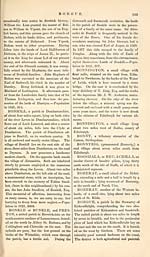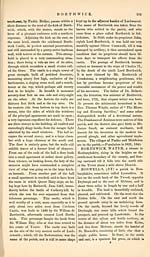Gazetteer of Scotland > Volume 1
(132) Page 104 - BOR
Download files
Complete book:
Individual page:
Thumbnail gallery: Grid view | List view

104
BORROWSTOUNNESS.
The old parish of Sandwick or Sanwich forms
the southern part of the present parish. The
ruins of its old church may be perceived on
the side of the bay. It is mentioned by tra-
dition that it was sacrilegiously plundered of
its plate by French pirates, at some time pre-
vious to the Reformation ; but that a storm
wrecked the vessel on a rock, which is nearly
opposite the church, where the pirates perished.
It has since been called the Frenchman's rock.
The church of Kirk- Andrew originally be-
longed to the monks of Iona ; and when the
devastations of the Danish pirates left them
without an establishment, William the Lion
transferred it, along with their churches and
estates in Galloway, to the monks of Holyrood.
It afterwards fell into the hands of the prior
and canons of Whithorn. The ancient kirk,
which was dedicated to the patron saint of
Scotland, stands in ruins on a creek of the
Solway, which from it is called Kirk- Andrews
Bay.— Population in 1821, 947.
BORLAND, a small village lying half a
mile north of Dysart in Fife.
BORLAND PARK, a small village south
of the Earn, parish of Auchterarder, Perth-
shire.
BOLEY, (LOCH) a small fresh-water
lake in the north of Sutherlandshire, parish of
Durness, containing great abundance of a spe-
cies of trouts called Red Bellies, which are
only fished for in October.
BORROWSTOWN, a fishing village on
the north coast of Sutherlandshire, parish of
Reay.
BORROWSTOUNNESS, (now gene-
rally pronounced BO'NESS,) a parish lying
on the south shore of the Firth of Forth,
county of Linlithgow, bounded by Carriden on
the east, Linlithgow on the south, and Pol-
mont on the west, extending four miles in
length by two and a half in breadth. The
land is fertile, and declines to the sea on the
north, and the river Avon on the west, Kin-
neil House, the property of the Duke of Ha-
milton, lately inhabited by the venerable Du-
gald Stewart, is a handsome edifice, with a
beautiful exposure to the firth. Kinneil is
supposed to signify " the head of the wall," in
allusion to the wall of Antoninus, which ter-
minates in its vicinity. " Penval," the only
surviving word of the Pictish language, which
must have been a dialect of the Celtic, is be-
lieved to be a various designation of the place,
signifying the same thing. Kinneil is an an-
cient seat of the Hamilton family, and having
generally been their residence, when politics
demanded that they shoidd not be far from the
capital, is very frequently mentioned in Scot-
tish history. The -village of Borrowstoun
lies about a mile inland, but the principal
town in the parish is called Borrowstounness,
or Bo'ness, which is situated on a piece ot
low ground on the coast. This is one of the
most ancient sea-port towns in Scotland, and
the greater part of its houses seem to be of a
very old date. From the number of works
in and about it, from whence smoke is profuse-
ly emitted, the streets, lanes, and houses ap-
pear dirty, mean, and saturated with soot.
It is a burgh of barony. The place possesses
a good safe harbour, but this not being a ma-
nufacturing district, there is little trade, import
or export, except of a local nature. A patent
slip is erected, and is of great use to shipping.
The port has three vessels employed in the
Greenland trade. Bo'ness is the chief salt-
making place in the Firth of Forth, and, it is
understood, exports upwards of 30,000 bushels
of this article yearly. Besides these works it has
two distilleries, an earthen-ware manufactory,
and vitrioland soap-work. Besides the establish-
ed church, there is a dissenting meeting-house.
The fast-days are generally the Wednesdays
before the second Sundays of February and
August. Prior to the middle of the seven-
teenth century, Kinneil was the name of the
parish, but the inhabitants of Borrowstoun-
ness having built a church for themselves,
the town was created a separate parish. In
1669, the Duke of Hamilton procured an act
of parliament for uniting the two districts, and
since that time the old landward church of
Kinneil has been neglected, and is now gone,
though the burying-ground remains. The liv-
ing of the joint parishes is now among the
best in the Kirk of Scotland, chiefly by reason
of a small farm having been endowed for the
use of the ministerial incumbents. — Popula-
tion in 1821, 3018.
BORTHWICK, a parish in the south-
eastern part of the county of Edinburgh, aver-
aging six miles in length by four in breadth,
bounded on the north by Crichton, on the east
by Fala, on the south by Heriot, and on the
west by Temple. The ground here is of an
irregular swelling nature, and is highly culti-
vated. The road from Edinburgh to the
BORROWSTOUNNESS.
The old parish of Sandwick or Sanwich forms
the southern part of the present parish. The
ruins of its old church may be perceived on
the side of the bay. It is mentioned by tra-
dition that it was sacrilegiously plundered of
its plate by French pirates, at some time pre-
vious to the Reformation ; but that a storm
wrecked the vessel on a rock, which is nearly
opposite the church, where the pirates perished.
It has since been called the Frenchman's rock.
The church of Kirk- Andrew originally be-
longed to the monks of Iona ; and when the
devastations of the Danish pirates left them
without an establishment, William the Lion
transferred it, along with their churches and
estates in Galloway, to the monks of Holyrood.
It afterwards fell into the hands of the prior
and canons of Whithorn. The ancient kirk,
which was dedicated to the patron saint of
Scotland, stands in ruins on a creek of the
Solway, which from it is called Kirk- Andrews
Bay.— Population in 1821, 947.
BORLAND, a small village lying half a
mile north of Dysart in Fife.
BORLAND PARK, a small village south
of the Earn, parish of Auchterarder, Perth-
shire.
BOLEY, (LOCH) a small fresh-water
lake in the north of Sutherlandshire, parish of
Durness, containing great abundance of a spe-
cies of trouts called Red Bellies, which are
only fished for in October.
BORROWSTOWN, a fishing village on
the north coast of Sutherlandshire, parish of
Reay.
BORROWSTOUNNESS, (now gene-
rally pronounced BO'NESS,) a parish lying
on the south shore of the Firth of Forth,
county of Linlithgow, bounded by Carriden on
the east, Linlithgow on the south, and Pol-
mont on the west, extending four miles in
length by two and a half in breadth. The
land is fertile, and declines to the sea on the
north, and the river Avon on the west, Kin-
neil House, the property of the Duke of Ha-
milton, lately inhabited by the venerable Du-
gald Stewart, is a handsome edifice, with a
beautiful exposure to the firth. Kinneil is
supposed to signify " the head of the wall," in
allusion to the wall of Antoninus, which ter-
minates in its vicinity. " Penval," the only
surviving word of the Pictish language, which
must have been a dialect of the Celtic, is be-
lieved to be a various designation of the place,
signifying the same thing. Kinneil is an an-
cient seat of the Hamilton family, and having
generally been their residence, when politics
demanded that they shoidd not be far from the
capital, is very frequently mentioned in Scot-
tish history. The -village of Borrowstoun
lies about a mile inland, but the principal
town in the parish is called Borrowstounness,
or Bo'ness, which is situated on a piece ot
low ground on the coast. This is one of the
most ancient sea-port towns in Scotland, and
the greater part of its houses seem to be of a
very old date. From the number of works
in and about it, from whence smoke is profuse-
ly emitted, the streets, lanes, and houses ap-
pear dirty, mean, and saturated with soot.
It is a burgh of barony. The place possesses
a good safe harbour, but this not being a ma-
nufacturing district, there is little trade, import
or export, except of a local nature. A patent
slip is erected, and is of great use to shipping.
The port has three vessels employed in the
Greenland trade. Bo'ness is the chief salt-
making place in the Firth of Forth, and, it is
understood, exports upwards of 30,000 bushels
of this article yearly. Besides these works it has
two distilleries, an earthen-ware manufactory,
and vitrioland soap-work. Besides the establish-
ed church, there is a dissenting meeting-house.
The fast-days are generally the Wednesdays
before the second Sundays of February and
August. Prior to the middle of the seven-
teenth century, Kinneil was the name of the
parish, but the inhabitants of Borrowstoun-
ness having built a church for themselves,
the town was created a separate parish. In
1669, the Duke of Hamilton procured an act
of parliament for uniting the two districts, and
since that time the old landward church of
Kinneil has been neglected, and is now gone,
though the burying-ground remains. The liv-
ing of the joint parishes is now among the
best in the Kirk of Scotland, chiefly by reason
of a small farm having been endowed for the
use of the ministerial incumbents. — Popula-
tion in 1821, 3018.
BORTHWICK, a parish in the south-
eastern part of the county of Edinburgh, aver-
aging six miles in length by four in breadth,
bounded on the north by Crichton, on the east
by Fala, on the south by Heriot, and on the
west by Temple. The ground here is of an
irregular swelling nature, and is highly culti-
vated. The road from Edinburgh to the
Set display mode to: Large image | Transcription
Images and transcriptions on this page, including medium image downloads, may be used under the Creative Commons Attribution 4.0 International Licence unless otherwise stated. ![]()
| Gazetteers of Scotland, 1803-1901 > Gazetteer of Scotland > Volume 1 > (132) Page 104 - BOR |
|---|
| Permanent URL | https://digital.nls.uk/97425946 |
|---|
| Description | Volume I: Abbey to Glenartney. |
|---|---|
| Attribution and copyright: |
|
| Description | By Robert Chambers and William Chambers. Glasgow: Blackie & Son, 1838. 2 volumes. |
|---|---|
| Shelfmark | NF.1461.g.7 |
| Additional NLS resources: | |

